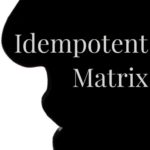Matrices Satisfying $HF-FH=-2F$

Problem 69
Let $F$ and $H$ be an $n\times n$ matrices satisfying the relation
\[HF-FH=-2F.\]
(a) Find the trace of the matrix $F$.
(b) Let $\lambda$ be an eigenvalue of $H$ and let $\mathbf{v}$ be an eigenvector corresponding to $\lambda$. Show that there exists an positive integer $N$ such that $F^N\mathbf{v}=\mathbf{0}$.
Sponsored Links
Contents
Hint.
- For (a), take the trace of the both sides of the given relation.
- For (b), show that if $F^k\mathbf{v}\neq \mathbf{0}$ then there are infinitely many eigenvalues, hence a contradiction.
Proof.
(a) The trace of the matrix $F$
Using the given relation we compute the trace of $F$ as follows.
By taking the trace of both sides we have
\[\tr(-2F)=\tr(HF-FH).\]
The right hand side is $-2\tr(F)$ and the left hand side is
\begin{align*}
\tr(HF-FH)&=\tr(HF)-\tr(FH)\\
&=\tr(HF)-\tr(HF)=0.
\end{align*}
Therefore we have $\tr(F)=0$.
(b) There exists an positive integer $N$ such that $F^N\mathbf{v}=\mathbf{0}$.
Since $\mathbf{v}$ is an eigenvector corresponding to the eigenvalue $\lambda$ of $H$, we have $H\mathbf{v}=\lambda \mathbf{v}$ or equivalently $(H-\lambda I)\mathbf{v}=\mathbf{0}$.
Now we compute
\begin{align*}
& F(H-\lambda I)=FH-\lambda F\\
&=(HF+2F)-\lambda F=(H-(\lambda-2)I)F.
\end{align*}
Therefore we have
\[F(H-\lambda I)=(H-(\lambda-2)I)F.\]
Evaluating at $\mathbf{v}$, we obtain
\[\mathbf{0}=F(H-\lambda I)\mathbf{v}=(H-(\lambda-2)I)F\mathbf{v}.\]
If $F\mathbf{v} \neq \mathbf{0}$, then this equality implies that $F\mathbf{v}$ is an eigenvector corresponding to the eigenvalue $\lambda-2$ of $H$. In this case we further calculate
\begin{align*}
\mathbf{0}&=F(H-(\lambda-2)I)F\mathbf{v} \\
&=(FH-(\lambda-2)F)F=(HF+2F-(\lambda-2)F)F\mathbf{v}\\
&=(H-(\lambda-4))F^2\mathbf{v}.
\end{align*}
If the vector $F^2\mathbf{v}\neq \mathbf{0}$, then this equality implies that $F^2\mathbf{v}$ is an eigenvector corresponding to the eigenvalue $\lambda-4$ of $H$.
Repeating this procedure, we see that
\[\mathbf{0}=(H-(\lambda-2k))F^k\mathbf{v}\]
for all $k$.
Therefore, if $F^k\mathbf{v}$ is nonzero vector for all $k$, then there are infinitely many eigenvalues $\lambda-2k$ but this is impossible since $H$ is an $n \times n$ matrix and hence $H$ has at most $n$ eigenvalues. Therefore there exists $N$ such that $F^N\mathbf{v}=\mathbf{0}$.
Related Question.
See the problem “Matrices satisfying the relation HE-EH=2E” for similar questions.
As noted there, the relation $HF-FH=-2F$ comes from the Lie algebra $\mathfrak{sl}(2)$.
 Add to solve later
Add to solve later
Sponsored Links














a simpler approach for B
$HF − FH= −2F$
If F is singular, then there must be at least one eigenvalue = 0, and we are done. (i.e. we are satisfied with natural number N = 1.)
Now suppose F is non-singular, and right multiply the equation by $F^{-1}$. This gives us
$H − FHF^{-1}= −2I$
now take the trace
$trace(H) − trace(FHF^{-1})= −2trace(I)$
$trace(H) − trace(F^{-1}FH)= −2n$
$trace(H) − trace(H)= −2n$
$0= −2n$
a contradiction. Hence F is singular and we’re done.
Dear D,
Your argument is correct if $\lambda=0$. But $\lambda$ is any eigenvalue of $A$, and even if $A$ is singular, there could be a nonzero eigenvalue of $A$.